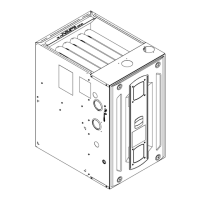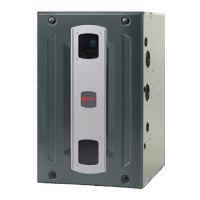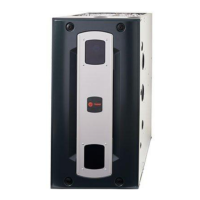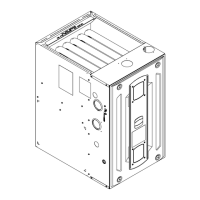S9V2-SVX001-1B-EN
37
10. Using a leak detection solution or soap suds, check
for leaks at the pressure outlet boss and pressure
tap test screw.
11. Turn on system power and check operation of the
unit.
Outlet Pressure Boss
2nd Stage (HI) Manifold Pressure Adjustment
1st Stage (LO) Manifold Pressure Adjustment
Inlet Pressure
Boss
Gas Valve On/Off
Toggle Switch
White-Rodgers 36J
Fuel Manifold Pressure Settings (inches w.c.)
Fuel 2nd Stage Max. 1st Stage Max.
Natural Gas 3.5” W.C. 1.7” W.C.
Propane Gas 10.0” W.C. 6.0” W.C.
High Altitude Derate
Input ratings (BTUH) of these Furnaces are based on
sea level operation and should not be changed at
elevations up to 2,000 ft. (610 m).
If the installation is 2,000 ft. (610 m) or above, the
Furnace input rate (BTUH) shall be reduced 4% for each
1,000 ft. above sea level.
Installations of this furnace at altitudes above 2,000 ft.
(610 m) shall be made utilizing the Vent Length table
and/or Part Numbers for Replacement Orifices table in
these installation instructions.
The Furnace input rate shall be checked by clocking the
gas flow rate (CFH) and multiplying by the heating
value obtained from the local utility supplier for the gas
being delivered at the installed altitude. Input rate
changes can be made by adjusting the Manifold
Pressure (min 3.0 - max 3.7 in. W.C. - Natural Gas) or
changing orifices (orifice change may not always be
required).
If the desired input rate can not be achieved with a
change in Manifold Pressure, then the orifices must be
changed. Propane installations will require an orifice
change.
IImmppoorrttaanntt:: Reinstall the replacement orifices to the
same depth as the orifices supplied with
the equipment.
See the table for help in selecting orifices if orifice
change is required. Furnace input rate and temperature
rise should be checked again after changing orifices to
confirm the proper rate for the altitude.
The vent length table shows the required vent lengths
for installations at various altitudes. Installations above
12,000 feet are not allowed.
PART NUMBERS FOR REPLACEMENT ORIFICES
DRILL SIZE PART
NUMBER
DRILL SIZE PART
NUMBER
44 ORF00501 54 ORF00555
45 ORF00644 55 ORF00693
46 ORF00909 56 ORF00907
47 ORF00910 57 ORF00908
48 ORF01099 58 ORF01338
49 ORF00503 59 ORF01339
50 ORF00493
Turn the main Gas Valve toggle switch within the unit
to the "OOFFFF" position. Turn the external gas valve to
"ON". Purge the air from the gas lines. After purging,
check all gas connections for leaks with a soapy
solution – DDOO NNOOTT CCHHEECCKK WWIITTHH AANN OOPPEENN FFLLAAMMEE..
Allow 5 minutes for any gas that might have escaped to
dissipate.
Propane Gas being heavier than air may require forced
ventilation. Turn the toggle switch on the Gas Valve in
the unit to the "ON" position.
The table in next page lists the main burner orifices
used with the furnace. If a change of orifices is required
to correct the furnace input rating refer to the part
number for replacement orifices table.
Installation of this furnace at altitudes above 2000 ft
(610m) shall be in accordance with local codes, or in
the absence of local codes, the National Fuel Gas Code,
ANSI Z223.1/NFPA 54 or National Standard of Canada,
Natural Gas and Propane Installation Code, CSA
B149.1.
FFuurrnnaaccee GGeenneerraall IInnssttaallllaattiioonn

